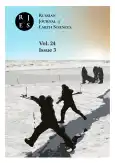WAVEFORM OF THE REFLECTED IMPULSE AT THE OBLIQUE SOUNDING OF THE SEA SURFACE
- Autores: Karaev V.1, Titchenko Y.1, Panfilova M.1, Meshkov E.1, Kovaldov D.1
-
Afiliações:
- Institute of Applied Physics of the Russian Academy of Sciences
- Edição: Volume 24, Nº 3 (2024)
- Páginas: ES3004
- Seção: Articles
- URL: https://journals.rcsi.science/1681-1208/article/view/263984
- DOI: https://doi.org/10.2205/2023ES000910
- EDN: https://elibrary.ru/rzdkcc
- ID: 263984
Citar
Texto integral
Palavras-chave
Sobre autores
V. Karaev
Institute of Applied Physics of the Russian Academy of Sciences
Email: volody@ipfran.ru
ORCID ID: 0000-0002-4054-4905
Yu. Titchenko
Institute of Applied Physics of the Russian Academy of Sciences
Email: yuriy@ipfran.ru
ORCID ID: 0000-0001-7762-7731
Researcher ID: S-7854-2016
candidate of physical and mathematical sciences
M. Panfilova
Institute of Applied Physics of the Russian Academy of Sciences
Email: volody@ipfran.ru
ORCID ID: 0000-0002-3795-0347
E. Meshkov
Institute of Applied Physics of the Russian Academy of Sciences
Autor responsável pela correspondência
Email: volody@ipfran.ru
ORCID ID: 0000-0002-5353-7528
D. Kovaldov
Institute of Applied Physics of the Russian Academy of Sciences
Email: d.kovaldov@ipfran.ru
ORCID ID: 0000-0002-9535-4949
Bibliografia
- Amarouche, L., P. Thibaut, O. Z. Zanife, J.-P. Dumont, P. Vincent, and N. Steunou (2004), Improving the Jason-1 Ground Retracking to Better Account for Attitude Effects, Marine Geodesy, 27(1–2), 171–197, https://doi.org/10.1080/01490410490465210.
- Barrick, D. (1968), Rough Surface Scattering Based on the Specular Point Theory, IEEE Transactions on Antennas and Propagation, 16(4), 449–454, https://doi.org/10.1109/TAP.1968.1139220.
- Bass, F. G., and I. M. Fuks (1979), Wave Scattering from Statistically Rough Surfaces, Elsevier, https://doi.org/10.1016/C2013-0-05724-6.
- Brown, G. (1977), The average impulse response of a rough surface and its applications, IEEE Transactions on Antennas and Propagation, 25(1), 67–74, https://doi.org/10.1109/TAP.1977.1141536.
- Fu, L.-L., and A. Cazenave (Eds.) (2000), Satellite Altimetry and Earth Sciences. A Handbook of Techniques and Applications (International Geophysics), 463 pp., Academic Press.
- Fu, L.-L., D. Alsdorf, E. Rodriguez, et al. (2009), The SWOT (Surface Water and Ocean Topography) Mission: Spaceborne Radar Interferometry for Oceanographic and Hydrological Applications, in OCEANOBS’09 Conference.
- Fuks, I. (1966), On the theory of radio wave scattering by the rough sea surface, Izvestiya VUZov. Radiofizika, 9(5), 876–887 (in Russian).
- Garnaker’yan, A. A. (1978), Radiolocation of the sea surface, Izdatel’stvo Rostovskogo universiteta, Rostov-on-Don (in Russian).
- Hauser, D., E. Soussi, E. Thouvenot, and L. Rey (2001), SWIMSAT: A Real-Aperture Radar to Measure Directional Spectra of Ocean Waves from Space-Main Characteristics and Performance Simulation, Journal of Atmospheric and Oceanic Technology, 18(3), 421–437, https://doi.org/10.1175/1520-0426(2001)0182.0.co;2.
- Hauser, D., C. Tison, T. Amiot, L. Delaye, N. Corcoral, and P. Castillan (2017), SWIM: The First Spaceborne Wave Scatterometer, IEEE Transactions on Geoscience and Remote Sensing, 55(5), 3000–3014, https://doi.org/10.1109/TGRS.2017.2658672.
- Isakovich, M. A. (1952), Scattering of waves from a statistically rough surface, Journal of Experimental and Theoretical Physics, 23, 305–314 (in Russian).
- Japan Aerospace Exploration Agency (2014), GPM Data Utilization Handbook. Version 1.0, JAXA, Japan.
- Ka, M.-H., and A. I. Baskakov (2015), Limiting accuracy of the dual-frequency microwave interferometry measurement for sea surface monitoring from space, Journal of Electromagnetic Waves and Applications, 29(16), 2199–2206, https://doi.org/10.1080/09205071.2015.1062806.
- Ka, M.-H., A. I. Baskakov, S.-Y. Jeon, I. Paek, and J. Jang (2016), Multi-frequency precision radar altimetry from space for estimation of sea surface state, Electronics Letters, 52(21), 1804–1805, https://doi.org/10.1049/el.2016.2356.
- Karaev, V. Yu., M. B. Kanevsky, P. D. Cotton, and P. G. Challenor (2002), Technical Note Is it possible to measure ocean surface slopes with a microwave radar at nadir probing?, International Journal of Remote Sensing, 23(16), 3251–3262, https://doi.org/10.1080/01431160110114970.
- Karaev, V. Yu., M. B. Kanevsky, G. N. Balandina, P. Challenor, C. Gommenginger, and M. Srokosz (2005), The Concept of a Microwave Radar with an Asymmetric Knifelike Beam for the Remote Sensing of Ocean Waves, Journal of Atmospheric and Oceanic Technology, 22(11), 1809–1820, https://doi.org/10.1175/JTECH1807.1.
- Karaev, V. Yu., M. E. Meshkov, and Y. L. Titchenko (2014), Underwater Acoustic Altimeter, Radiophysics and Quantum Electronics, 57(7), 488–497, https://doi.org/10.1007/s11141-014-9531-8.
- Kurjanov, B. (1962), Scattering of sound on a rough surface with two types of roughness, Akustichesky zhurnal, 8(3), 325–333 (in Russian).
- Meshkov, E. M., and V. Y. Karaev (2004), Determination of the Parameters of Sea-Surface Roughness Using the Doppler Spectrum of a Microwave Radar Signal Reflected from a Water Surface, Radiophysics and Quantum Electronics, 47(3), 205–217, https://doi.org/10.1023/B:RAQE.0000036565.31198.87.
- NASA (2024), SWOT: Surface Water and Ocean Topography, https://swot.jpl.nasa.gov/.
- Raney, R. K. (1998), The delay/Doppler radar altimeter, IEEE Transactions on Geoscience and Remote Sensing, 36(5), 1578–1588, https://doi.org/10.1109/36.718861.
- Raney, R. K. (2012), CryoSat SAR-Mode Looks Revisited, IEEE Geoscience and Remote Sensing Letters, 9(3), 393–397, https://doi.org/10.1109/LGRS.2011.2170052.
- Tikhonov, V. (1982), Statistical radio engineering, 624 pp., Radio i Svyaz, Moscow.
- Titchenko, Yu., G. Jie, V. Karaev, K. Ponur, M. Ryabkova, V. Baranov, V. Ocherednik, and Y. He (2024), Preliminary Performance Assessment of the Wave Parameter Retrieval Algorithm from the Average Reflected Pulse, Remote Sensing, 16(2), 418, https://doi.org/10.3390/rs16020418.
- Valenzuela, G. R. (1978), Theories for the interaction of electromagnetic and oceanic waves? A review, Boundary-Layer Meteorology, 13(1–4), 61–85, https://doi.org/10.1007/BF00913863.
- Wright, J. (1968), A new model for sea clutter, IEEE Transactions on Antennas and Propagation, 16(2), 217–223, https://doi.org/10.1109/TAP.1968.1139147.
- Zieger, A. R., D. W. Hancock, G. S. Hayne, and C. L. Purdy (1991), NASA radar altimeter for the TOPEX/POSEIDON Project, Proceedings of the IEEE, 79(6), 810–826, https://doi.org/10.1109/5.90160.
- Zubkovich, S. (1968), Statistical characteristics of radio signals reflected from the earth’s surface, 224 pp., Sovetskoe radio, Moscow.
Arquivos suplementares










